Physical Address
304 North Cardinal St.
Dorchester Center, MA 02124
Age-related changes occur in all layers of the face, including skin, superficial fat, superficial musculo-aponeurotic system (SMAS), deep fat, and bone.
Patients presenting for facial rejuvenation surgery are usually middle-aged or older, thus increasing the chance of comorbidities. Risk factors such as hypertension and smoking should be dealt with prior to facelift surgery.
Careful preoperative assessment will provide the surgeon with an aesthetic diagnosis regarding the underlying facial shape, the age-related issues that predominate, and the appropriate surgical procedures for every individual patient.
Almost all facelift techniques begin with a subcutaneous facelift flap. Careful incision placement, tissue handling, and flap repositioning are important in order to avoid the obvious stigmata of facelift surgery.
In its pure form, the subcutaneous, skin-only facelift has a limited effect on the position of heavier deep tissue.
In SMAS plication, a skin flap is created with suture manipulation of the superficial fat and the underlying SMAS/platysma.
In loop suture techniques (minimal access cranial suspension [MACS] lift), a skin flap is created with long suture loops taking multiple bites of superficial fat and platysma – fixed to a single point on the deep temporal fascia.
The supraplatysma plane creates a single flap of skin and superficial fat mobilized and advanced along the same vector.
SMASectomy involves a skin flap plus excision of superficial fat and SMAS from the angle of the mandible to the malar prominence, with direct suture closure of the resulting defect.
A SMAS flap raised with skin attached (deep plane) creates a flap of SMAS/platysma, superficial fat and skin, all mobilized and advanced along the same vector.
A separate SMAS flap (dual plane) creates two flaps, the skin flap and the superficial fat/SMAS/platysma, which are advanced along two different vectors.
The subperiosteal lift involves dissection against bone, with mobilization and advancement of all soft-tissue elements.
Additional volume augmentation, and in some locations volume reduction, should be considered in all cases of facelift surgery.
Facial aging is usually a pan-facial phenomenon. Therefore, in order to obtain a harmonious result, patients will often benefit from surgery to other components of their face.
The most common complication of facelift surgery is hematoma. This problem should be dealt with promptly.
Access video and video lecture content for this chapter online at Elsevier eBooks+ ![]()
![]()
Complete facial rejuvenation involves the forehead, periorbital region, cheek, neck, and perioral region. In this chapter, we deal with the middle and lower thirds of the face – the cheek and neck. Terminologies for procedures that address these areas include rhytidectomy, rhytidoplasty, meloplasty, and facialplasty, although in this text, the more common term “facelift” will be used.
Facelift surgery was originally conceived as a method of placing traction on the aging face by excising skin in the periphery of the face and closing the resulting defect under tension. Since that simple beginning over 100 years ago, the procedure has evolved to encompass a wide range of techniques which lift, augment, and rearrange facial tissues.
Despite the development of many less invasive technologies, nothing can match a facelift in its ability to globally treat the face, returning its basic architecture to a more youthful configuration.
The classic stigmata of the aging face involve multiple changes ( Fig. 9.3.1 ):
Visible changes in skin, including folds, wrinkles, dyschromias, dryness, and thinning.
Folds in the skin and subcutaneous tissue created by chronic muscle contraction: glabellar frown lines, transverse forehead lines, and crow's feet over the lateral orbital rim.
Deepening folds between adjoining anatomic units: the nasojugular fold (tear trough), nasolabial folds, marionette lines, and submental crease.
Ptosis of soft tissue, particularly in the lower cheek, jowls, and neck.
Loss of volume in the upper two-thirds of the face, which creates hollowing of the temple, the lateral cheek, the central midface and in the upper lip, premaxillary area between the two nasolabial folds. The result is a more skeletal appearance in the temple, the periorbita, and the malar region as well as deepening of the nasolabial folds.
Expansion of volume in the neck and lateral jawline, which leads to the formation of jowls and fullness of the neck. The driving force behind our ability to explain these many changes has been an improved understanding of facial anatomy and how it changes over time. Facial aging occurs in all its layers, from skin down to bone; no tissue is spared. The face can be considered a five-layer structure as described in Chapter 9.2: skin, subcutaneous fat, the superficial musculo-aponeurotic system (SMAS) and muscles of facial expression, fascial spaces, and deep fascia ( Fig. 9.3.2 ). Underlying everything is bone, except over the oral cavity. The surgical significance of this concentric layer arrangement is that dissection can be done in the planes between the layers so that anatomical changes in each of the layers can be addressed independently.
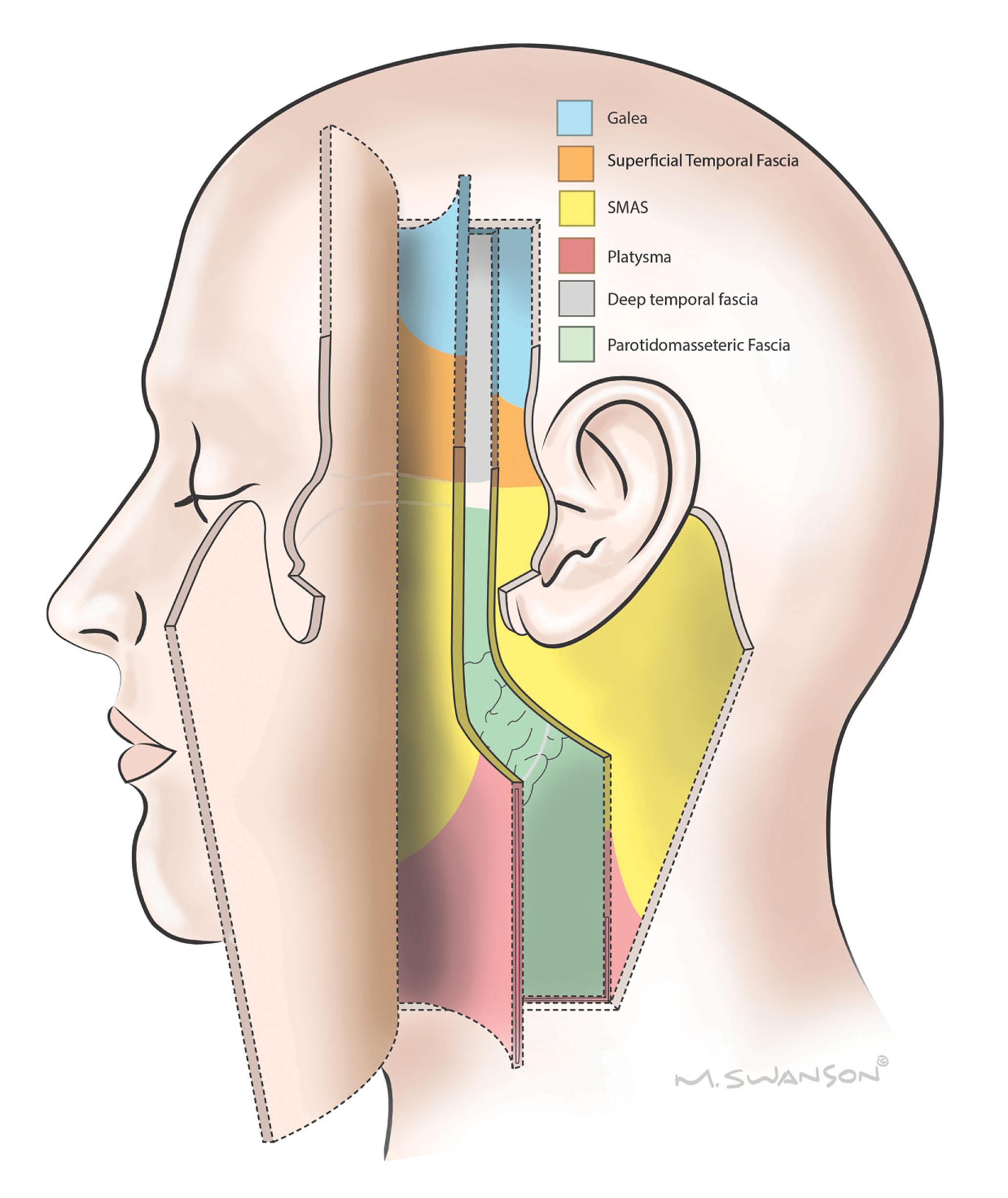
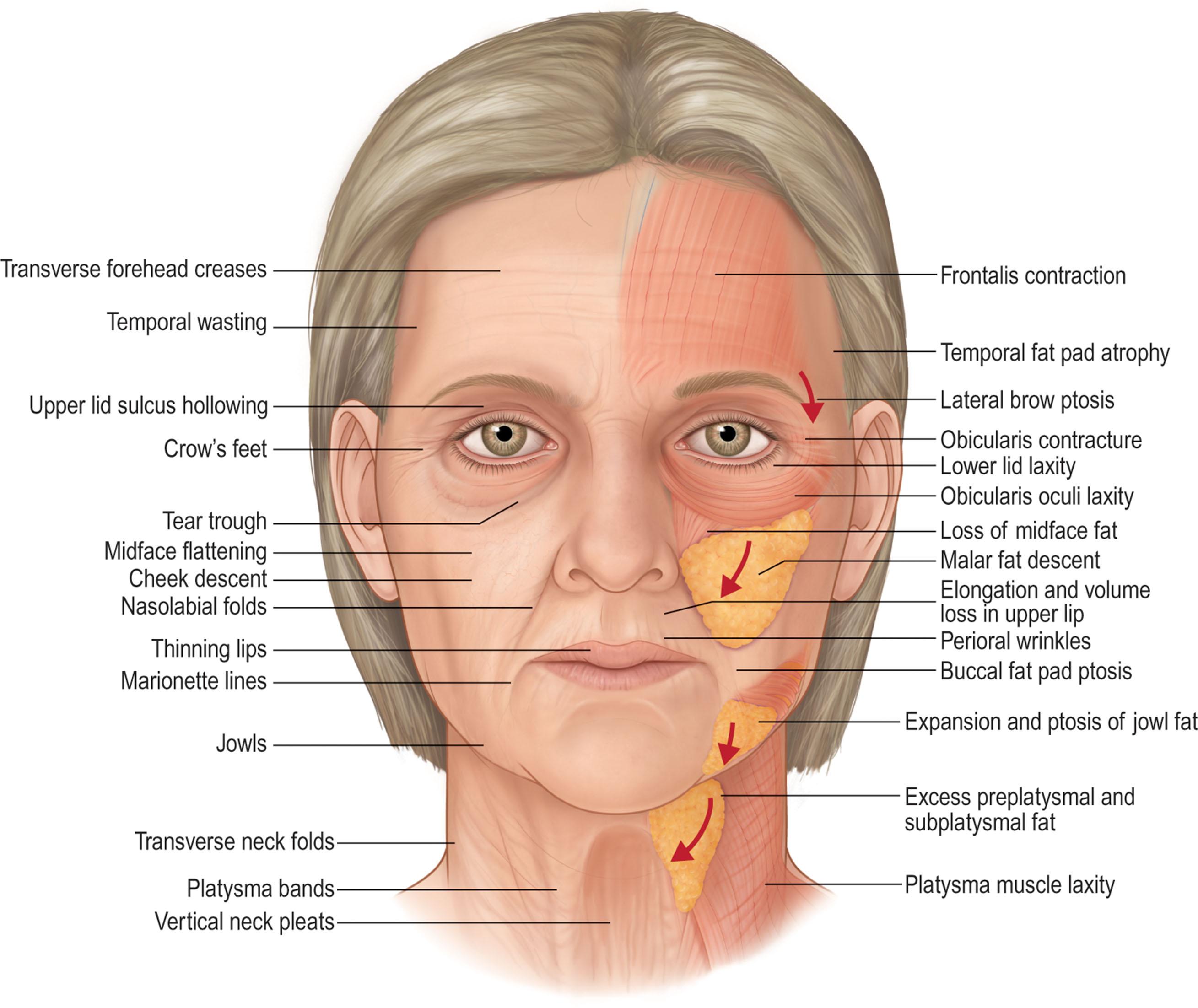
Skin is directly adherent to underlying subcutaneous fat via the retinacular cutis system. In certain predictable areas, the skin is tethered to bone or underlying muscle by condensed areas of connective tissue. These can be string-like cutaneous ligaments or ribbon-like septae. Because nerves and vessels often reach the skin adjacent to these vertically running fibrous structures, dissection of skin is more difficult and bloody where the skin is tethered. McGregor's patch is such an area because of its association with the zygomatic cutaneous ligaments and a perforating branch of the transverse facial artery.
Surface changes in facial skin are some of the most obvious signs of aging. Skin aging is both intrinsic and extrinsic. Intrinsic aging is the result of genetically determined apoptosis. The skin becomes thinner; there is a decrease in melanocytes, a reduced number of fibroblasts, and a loss of skin appendages, leading to dryness. In the dermal matrix, there is fragmentation of the collagen and impairment of fibroblast function. Thinner skin becomes more susceptible to the repeated contraction of underlying facial muscles, which leads to permanent skin folds in predictable locations ( Fig. 9.3.3 ). Extrinsic forces include sun exposure, cigarette smoke, extreme temperatures, and weight fluctuations.
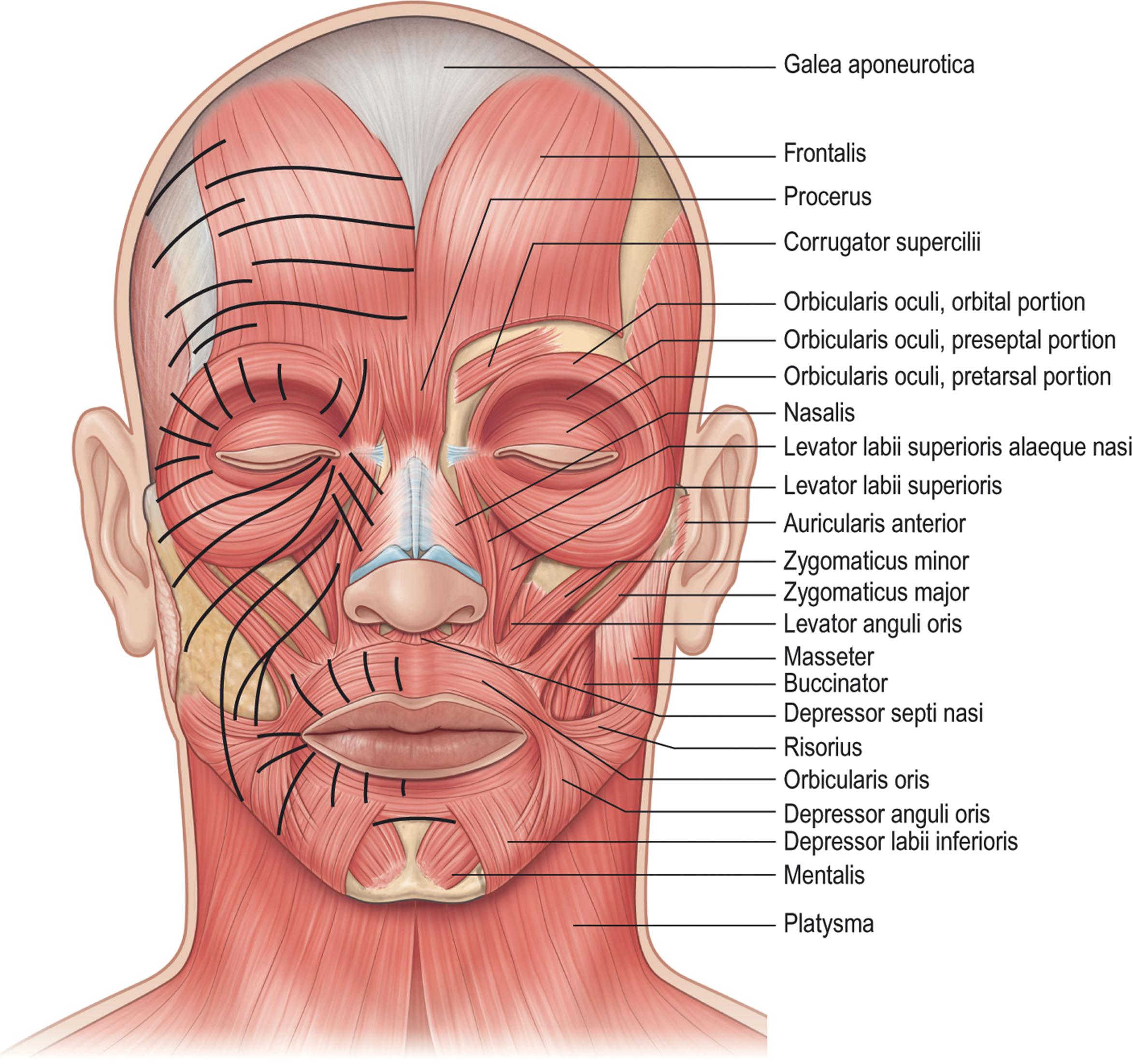
The net result is that aging facial skin becomes weaker, thinner, and dryer. It also loses its ability to recoil, a condition called elastosis. This has surgical implications, because firm tight skin is youthful, and to varying degrees, the tightening of loose facial skin contributes to the surgical result. However, a facelift does not improve the quality or the texture of the skin. Therefore, patients with good-quality skin are likely to enjoy better results from facelift surgery than patients with poor-quality skin. When skin quality is poor, options such as injectable fillers and skin resurfacing may be more appropriate for rejuvenation than facelift surgery. In most cases of facial rejuvenation, medical and surgical therapies can work in concert for a more complete result.
Facelift surgery dates from the early part of the 20th century. Its colorful history has been thoroughly reviewed by Stuzin.
In the past, the history of aesthetic facial surgery has been reported by a number of authors, including Rogers, Rees and Wood-Smith, Gonzalez-Ulloa, Rees, and Barton.
There is still doubt as to who performed the first facelift, but most sources date it to the first decade of the twentieth century. According to Rogers, Hollander reported in a chapter entitled “Cosmetic surgery” in Handbuch der Kosmetik that “as a victim of the art of feminine persuasion”, he removed pieces of skin at the margins of the hairline and in the natural aging skinfolds of a woman to freshen up “her wrinkles and drooping cheeks”. In this chapter, Hollander did not date the procedure, but in 1932 he stated that his original procedure had been performed in 1901 for a Polish aristocrat. Lexer, however, reported in 1931 that he had performed a facelift for an actress in 1906 and that he was unaware of any such operation before that date. Joseph reported in 1921 that he had performed an operation in 1912 for correction of aging cheek tissues in a 48-year-old woman. By the time Hollander, Lexer, and Joseph reported their first procedures, a number of other prominent surgeons in Europe, such as Noel, Passot, Morestin, Bourguet, and Lagarde, were busy performing cosmetic surgical procedures. In the United States, Miller and Kolle had large cosmetic surgery practices. Passot in 1919 published an illustrated article showing sites of elliptic skin excision of the hairline, the forehead, and the temporal and preauricular areas to tighten the skin and an elliptic excision of skin and fat to reduce submental fat deposits. Bourguet reported elliptic skin excisions similar to those of Passot. He was the first to report fat excisions to correct herniated periorbital fat pads (1924) and to publish preoperative and postoperative photographs of fat pad excision (1925). Noel published a book in 1926, La Chirurgie Esthetique : Son Role Social , describing facialplasty, blepharoplasty, forehead lifting, and correction of loose skin of the neck, burns, scars, protruding ears, and laxity of the upper arms. Although her procedures were not aggressive by modern standards, Noel was a true master of that era.
Miller published the first book in medical history devoted entirely to the subject of cosmetic surgery. Miller was described by Rogers as a “quack” on one hand and at the same time, “a surgical visionary years ahead of his academic colleagues … medicine's first truly cosmetic surgeon.” Miller was a prolific writer. In 1906, he wrote the first article in the medical literature describing an attempt to remove excess skin from the eyelids. In 1907, he published the first article with a photograph illustrating lower eyelid incisions, and he also published three cosmetic surgery textbooks. Kolle was born in Germany and practiced in New York. His book Plastic and Cosmetic Surgery represented the second description of cosmetic surgery in medical history. The book was more than 500 pages in length and contained hundreds of illustrations, including preoperative and postoperative photographs of protruding ears; it took a rather aggressive surgical approach to the correction of excess skin of the eyelids. Bettman was the first to publish preoperative and postoperative facelift photographs and to describe a continuous temporal scalp, preauricular, postauricular, and mastoid area incision. With modifications, his incision is essentially that used for facialplasty today. Hunt published a book, Plastic Surgery of the Head, Face and Neck , that included facelifting and forehead/browlifting operations.
All the early facialplasty procedures were limited to skin excision and wound closure without subcutaneous undermining. Bames described subcutaneous face and neck undermining, skin redraping, and excision of excess skin. The continuous incision described by Bettman and subcutaneous undermining recommended by Bames essentially established the basic facelift procedure for the next 40 years. As discussed by Rees, a great deal of secrecy surrounded early facelift procedures. Surgeons were reluctant to share their techniques because of professional jealousy and greed. The disdain for “vanity” surgery by both the medical profession and the public restricted most facelift procedures to private offices and small clinics. The extent of surgery in such settings was necessarily limited. Many prominent plastic surgeons in major medical centers were forced to perform their facelifts in small clinics or to hide their cases by misnaming the procedures on the operating schedule. Renowned plastic surgeons after the First and Second World Wars, such as Gillies, Blair, Davis, Pierce, McIndoe, Mowlem, Conway, and others, did a great deal of cosmetic surgery but were reluctant to publish on the subject. The conventional facelift operation (skin dissection only) failed to address the effect of aging and the force of gravity on the structures (e.g., muscle, fat, and superficial fascia) deep to the skin. Likewise, the classic skin dissection facialplasty failed to account for the wide variation in facial, jawline, and cervical deformities; in the location of fat deposits; in the asymmetry of anatomic structures; and in the genetically determined deformities, such as microgenia and the obtuse cervicomental angle.
Aufricht discussed the limitations of the subcutaneous facelift, particularly its failure to correct submental fat deposits and platysma bands. Adamson and colleagues discussed correction of the platysma bands in the submental area, and Millard and co-workers recommended extensive submental defatting. Pennisi and Capozzi and Baker and Gordon described suture plication of the deep tissues of the cheek and lateral neck. Tipton challenged the deep suture techniques in a study of 33 patients in whom he performed unilateral plication. Two years postoperatively, there was no obvious difference in the two sides of the face. In 1973 Skoog described a technique of dissection of the superficial fascial layer in the face, in continuity with the platysma muscle in the neck and advancement of the myofascial unit in a cephaloposterior direction. This was the beginning of the modern era in facelifting.
Subsequent to Skoog’s innovation, Mitz and Peyronie used cadaver dissections to define the superficial musculo-aponeurotic system (SMAS) in the face and noted that tightening of this layer would be beneficial in facialplasty. SMAS-platysma facelifting, wide skin undermining, and extensive fat removal soon gained worldwide popularity. Many surgeons went on to describe different techniques involving SMAS-platysma repositioning. Lemmon and Hamra and later Barton, modified the Skoog technique focusing on a composite flap of SMAS and skin.
In 1989, Furnas, described the retaining ligaments of the midface, which led to a better understanding of anatomic areas where facial soft tissue is supported and the involvement of these ligaments in leading to the anatomic changes that occur with aging. These ligaments were further defined by others who thought that loss of the support from the retaining ligament system allowed facial fat to descend inferiorly in the face, deepening the nasolabial fold and forming facial jowls with aging. Knowledge of the retaining ligaments led to modifications in procedures involving ligament release in subSMAS dissection, Stuzin, Aston, Connell and Owsley all advanced the concept of a separate skin and SMAS flap, with the SMAS used to reposition descended facial fat. Other surgeons, preferring subperiosteal rather than subSMAS dissection to reposition fat, developed procedures whose similar goal is to resuspend descended malar fat to the malar eminences using the subperiosteal plane. A combination of subperiosteal and subcutaneous lifting has also been described.
In the neck, Connell and Feldman identified the platysma as a critical component to be modified for adequate rejuvenation of the entire face.
In concert with attempts to reposition facial fat, astute observations were eventually made about the age-related deflation of the human face. This led to the use of injected fillers and injected fat (lipofilling), championed by Coleman, in order to re-inflate the aging face, either independently or at the same time as facelift surgery. Later, anatomic dissections determined that facial fat is in distinct compartments both in the superficial and deep layers of the face.
The face is carpeted in a layer of superficial fat immediately deep to the dermis. Between individuals, there is much variability in the thickness of this superficial fat layer. This has surgical implications because heavier patients have thicker, heavier tissues to reposition. With thinner patients, the weight of tissue to be lifted is less, but facial layers are packed closely together, like an onion, increasing the difficulty in surgical separation of the skin from SMAS and SMAS from underlying structures. The malar fat pad is a thickened area of superficial fat overlying the zygomatic body. This is a triangular-shaped mass bordered by the nasolabial fold, the infraorbital arch, and a diagonal line across the midcheek. Its apex is over the malar eminence ( Fig. 9.3.4 ).
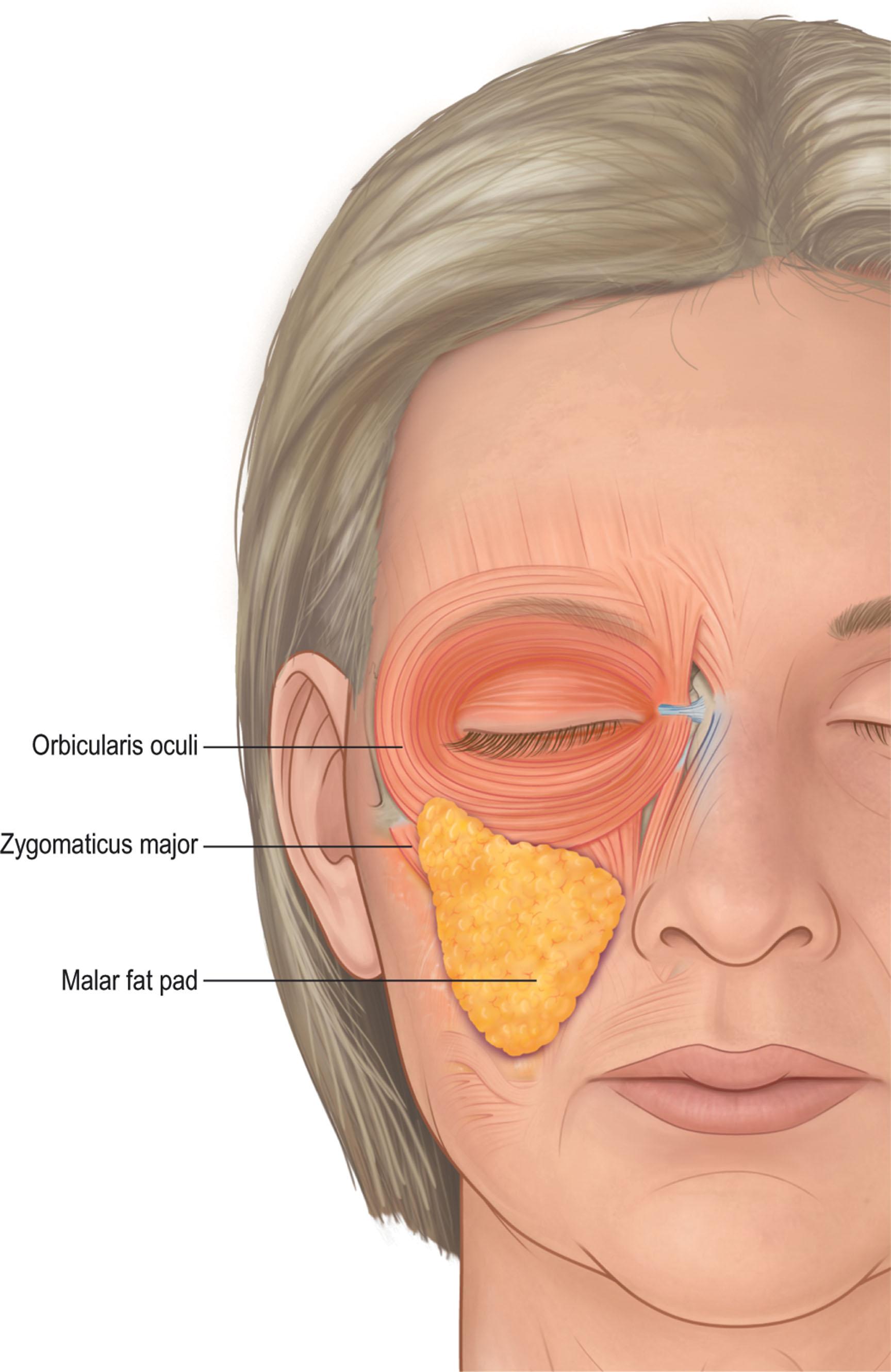
One study looked at fat volume in the cheek and found 56% of the fat superficial to the SMAS and 44% deep to the SMAS and the muscles of facial expression. The superficial fat is separated by vertical septae into five distinct compartments: nasolabial, medial cheek, middle cheek, lateral temporoparietal, and the inferior orbital fat ( Fig. 9.3.5 ). The two central fat compartments (medial and middle) are the primary components of the malar fat pad.
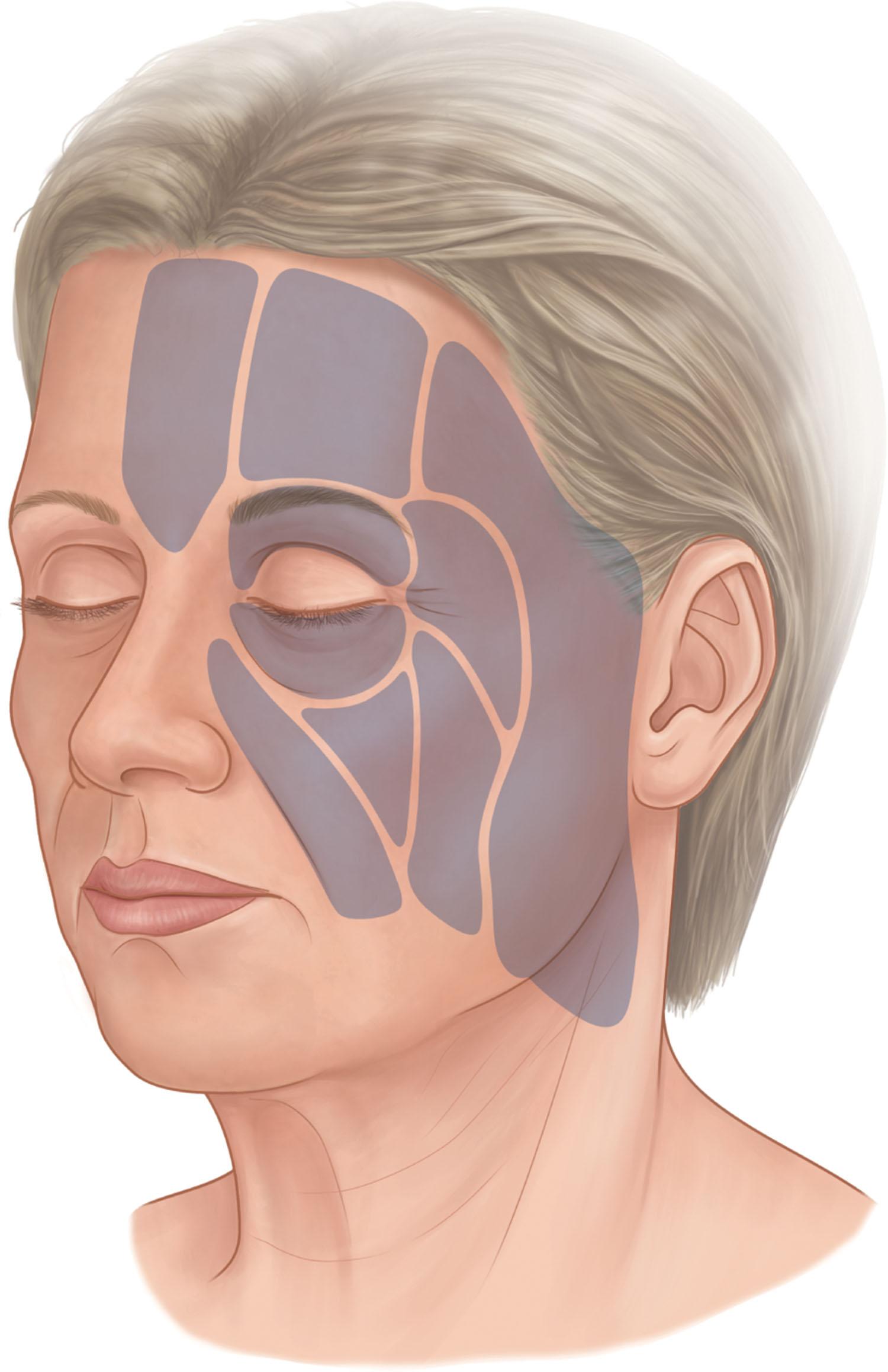
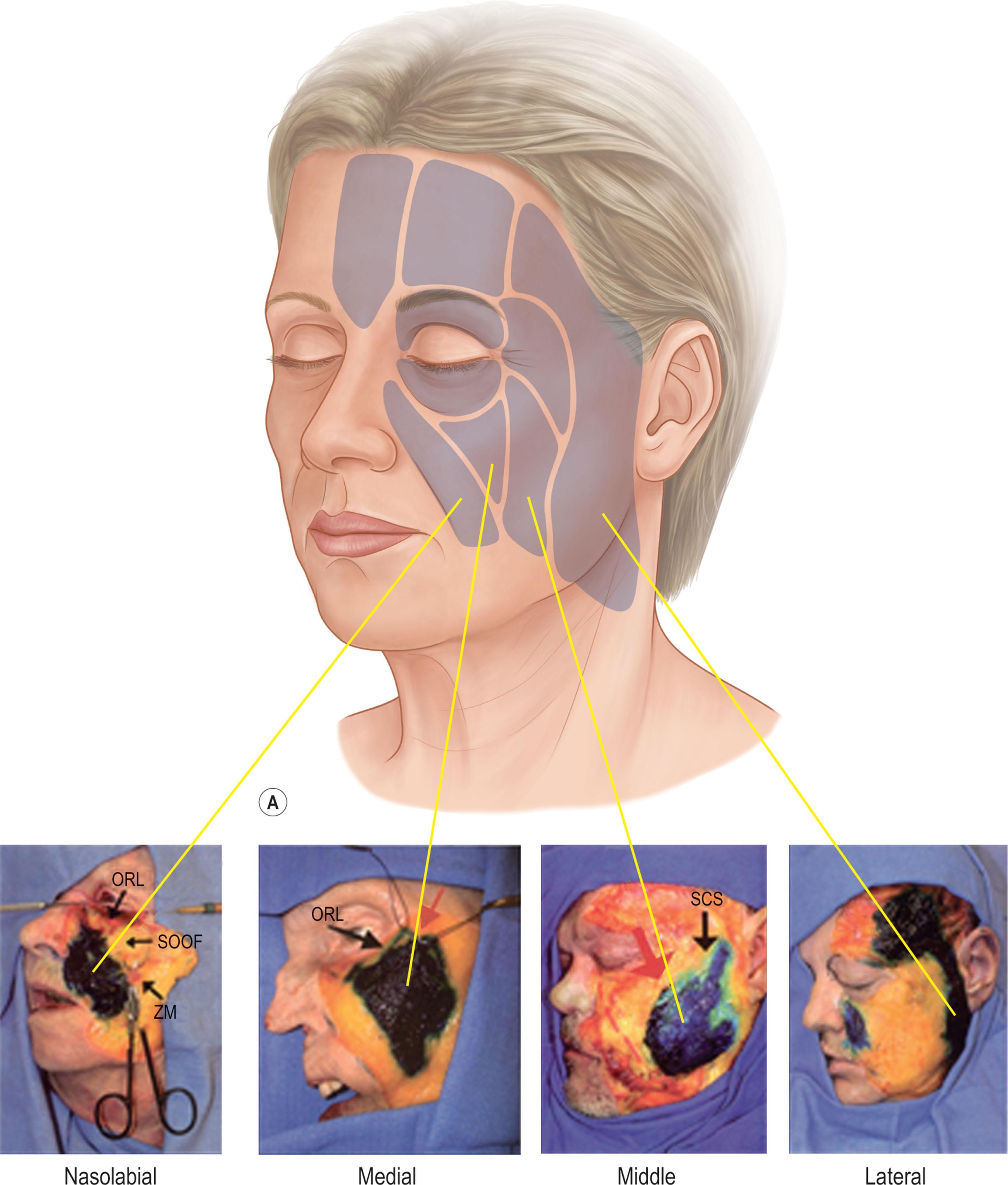
The deep fat is also compartmentalized ( Fig. 9.3.6 ). Current terminology identifies the pyriform space medially, the deep medial fat compartment and the suborbicularis oculi fat (SOOF) – medial and lateral portions.
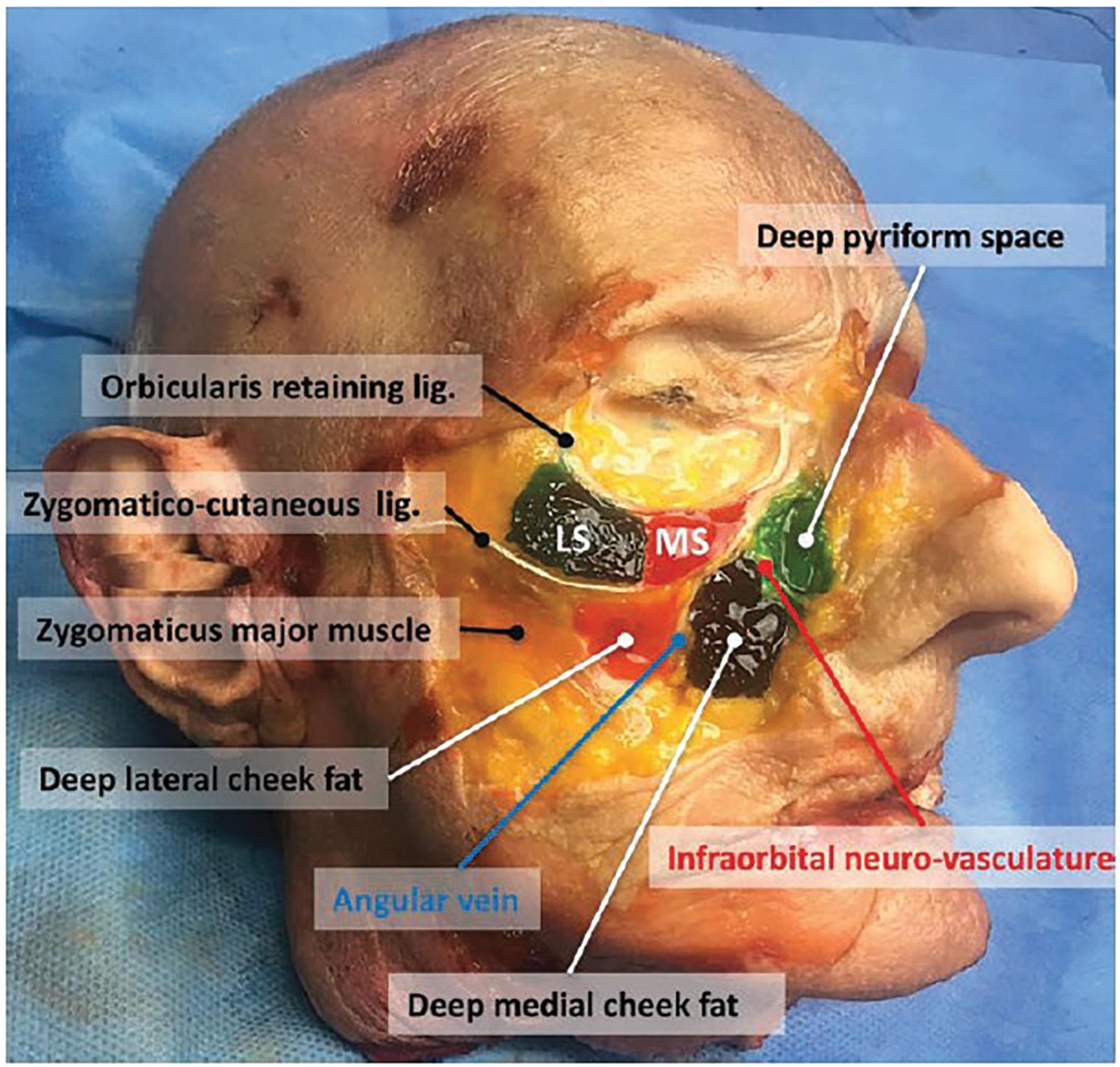
It has been theorized that age-related deflation in the deep fat leads to “pseudoptosis” of the overlying superficial fat and skin – ptosis that is real but caused by a lack of underlying support. Using computed tomography (CT) scans over time in the same subjects, a significant loss of fat was observed from both superficial and deep fat compartments, although there is a greater percentage of loss in the deep fat layer. This contributes to changes such as the “inverted V deformity” below the infraorbital rim.
Using sophisticated photographic analysis and facial averaging, Lambros identified significant age-related loss of volume in the premaxillary and perioral zone. The result is decreased projection of premaxillary soft tissue, an elongated upper lip and deepening of the nasolabial folds.
In youth, facial fat is tightly packed, creating surface contours which undulate smoothly from convexity to concavity. The malar fat pad creates the principal cosmetic highlight zone in the youthful face. In the aging face, fat is less tightly packed, and facial contours become more abrupt. In areas of tight ligamentous attachment, such as the preparotid area, the anterior jowl border, and the zygomatic ligament insertions, visible depressions develop.
Surgeons have traditionally viewed superficial cheek fat as a ptotic layer that requires repositioning. In support of this theory, it has been demonstrated that the primary muscles of facial expression in the midcheek (zygomaticus major and minor) do not change in length, while the overlying fat migrates inferiorly. Another study, using CT scans, identified age-related inferior migration of the midfacial fat compartments as well as inferior volume shift within the individual compartments.
In the lower face, the jowl area appears to thicken with age, making the mandible appear wider. Sometimes called radial expansion, this may be caused by fat hypertrophy, or by soft-tissue ptosis within the premasseteric space, a natural glide plane”. Below the mandible, fat distribution in the neck evolves over time with a decrease in fat in the lower third of the neck, but an increase in the upper third, contributing to a more obtuse cervicomental angle.
The combination of volume loss in some areas, volume gain in others, and soft-tissue ptosis creates a cascade effect resulting in the loss of natural youthful curves ( Fig. 9.3.7 ).
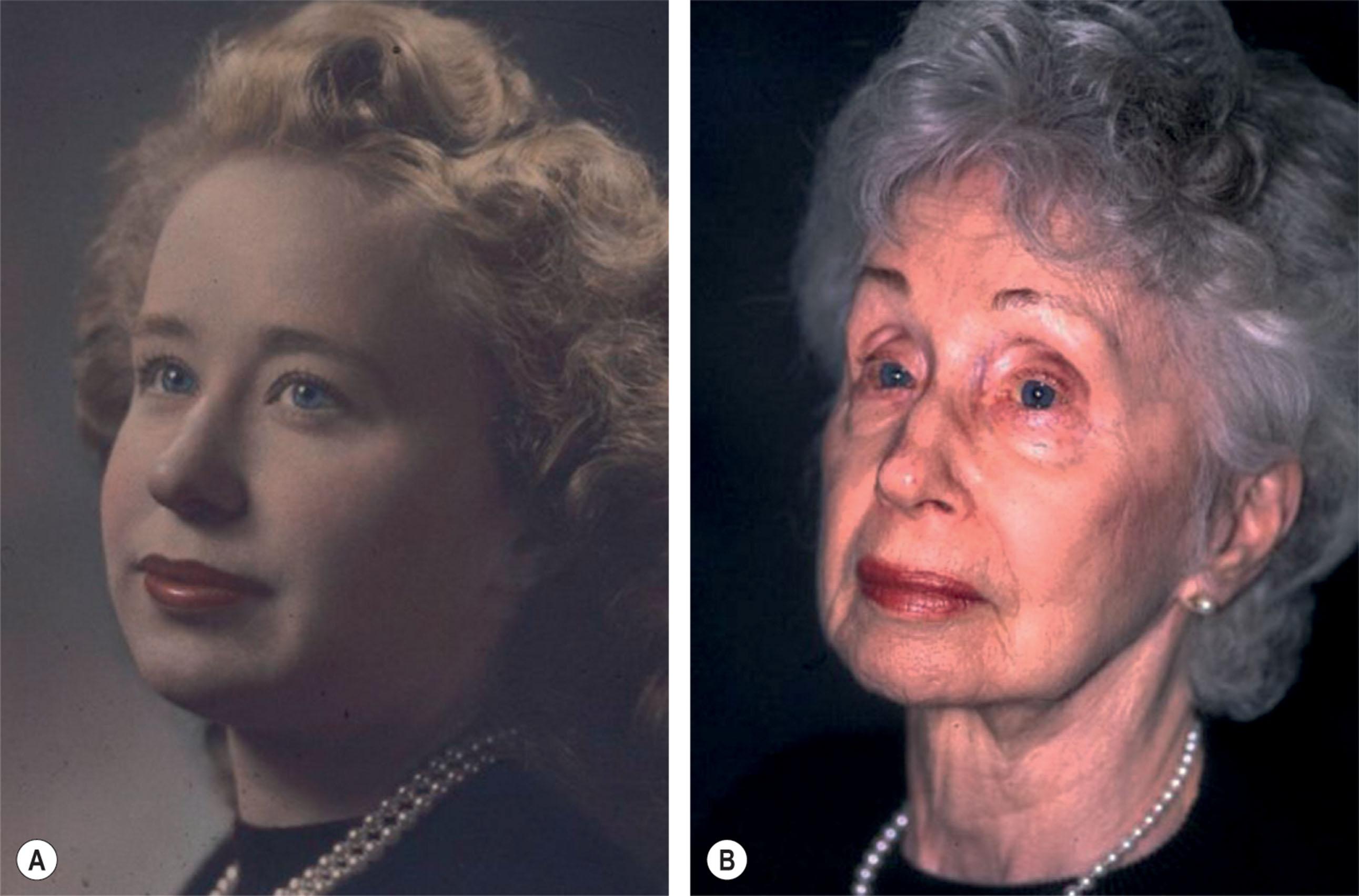
Gradually, the cheek fullness of youth gives way to jowl formation and upper neck fullness associated with age. The face changes from a heart shape to a more rectangular shape, or from an egg sitting on its narrow end to an egg resting on its broad end. This has been called losing the “inverted cone of youth” and has been likened to a reversal of the “Ogee” curve, a natural S-shaped curve seen in architecture.
Immediately deep to the subcutaneous fat is the SMAS, described by Mitz and Peyronie in 1976. The SMAS can be thought of as a continuous fascial sheath encompassing the entire face and neck. Superiorly, it continues into the temple as the superficial temporal fascia (temporoparietal fascia) and then into the scalp as the galea aponeurotica. Inferiorly, into the neck, the SMAS continues as the superficial cervical fascia, which envelopes the platysma muscle. Clinically, the thickness and strength of the SMAS varies between patients, and by location, being thicker and strongest posteriorly over the parotid and weakest anteriorly. During surgical dissection, the SMAS is most tenuous under the malar fat pad where it splits to encompass the zygomaticus major and the orbicularis oculi. The SMAS has several important surgical implications. Its fibrous attachments to skin allow it to act as a carrier for overlying subcutaneous fat; also it has been shown to be much more resistant to stretch than skin. Furthermore, below the zygomatic arch, all branches of the facial nerve are deep to the SMAS. Therefore, dissection superficial to the SMAS is safe.
The relationship of the SMAS (superficial fascia of the face) to the deep fascia of the face involves areas of mobility interspersed between areas of attachment. SMAS is tethered to the deep fascia by retaining ligaments over the parotid gland, at the inferior border of the zygomatic body, and along the anterior edge of the masseter (see Chapter 9.2 and later in this chapter). Between these areas of fixation, the SMAS is free to move over the underlying deep fascia. These are the suprazygomatic zone where superficial temporal fascia slides over the deep temporal fascia, the midcheek where SMAS rides over the parotid masseteric fascia (premasseteric space), and the neck where the platysma lies unattached over the underlying strap muscles.
The muscles of facial expression are found in two layers: superficial and deep. The superficial muscles are orbicularis oculi, orbicularis oris, zygomaticus major, zygomaticus minor, levator labii superioris, risorius, and depressor anguli oris. These muscles are innervated on their deep surface by branches of the facial nerve (VII). Consequently, surgical dissection on the superficial surface of these muscles will not endanger their innervation. The only facial muscles innervated on their superficial surface are the muscles in the deep layer: mentalis, levator anguli oris and buccinator. The three facial muscles most important to surgeons are orbicularis oculi and platysma – because they are often manipulated during facelift surgery – and zygomaticus major – because it is used as a landmark in certain facelift techniques (see Figure 9.3.3 ).
Most muscles of facial expression take their origins from bone and insert into the dermis, thus allowing for voluntary and involuntary movement of facial soft tissues. Platysma is a purely subcutaneous muscle taking its origin from the fascia of the pectoralis and inserting into soft tissue of the face, with a small bony insertion on the anterior mandible. It is also tethered posteriorly to the sternocleidomastoid (SCM) muscle via the cervical retaining ligaments. The platysma interdigitates with the depressor labii inferioris and in some individuals the platysma provides some effect on the depression of the lower lip. The platysma is thickest in the neck and can be visualized when a patient grimaces. As the muscle courses superiorly, crossing the mandibular border, it becomes much thinner. In some individuals the platysma can be found extending well into the midcheek, occasionally approaching the lower fibers of the orbicularis oculi.
While most muscles of facial expression do not change appreciably with age, the orbicularis oculi and the platysma undergo age-related changes. Both muscles have a large surface area and are relatively thin – a configuration lending them to potential redundancy if they lose tone or if their deep tissue attachment is attenuated. For example, in some individuals redundancy develops in the lower half of the orbicularis, a condition that is a speculated cause of lower eyelid festoons. Some have suggested that it is the loss of support of the orbicularis through attenuation of the orbicularis retaining ligament (orbitomalar ligament) that contributes to deformities of the lower eyelid/cheek junction. Similarly, the paired platysma muscles, which are encased by SMAS, appear to gradually fall away from their deep cervical attachment carrying the overlying fat and skin. The net result is a more obtuse cervicomental angle and the development of visible platysma bands at the anterior platysmal border. Another issue common to orbicularis oculi and platysma is that these are the only facial muscles that are undermined during certain surgical procedures, thus imperiling some of their motor innervation. Fortunately, the orbicularis has multiple motor nerve branches providing a level of collateral innervation. There is a less-elaborate innervation to the platysma; two or three cervical branches can be identified just inferior and anterior to the angle of the mandible in the plane between the deep cervical fascia and the undersurface of the platysma. Preservation of these branches is potentially important because the platysma acts as a support structure and also influences lower lip depression, especially in those individuals with a “full dentition” smile.
Facial soft tissue and skin are held in place by retaining ligaments running from underlying fixed bone or fascia, through facial fat, inserting into the dermis. ( Fig. 9.3.8 ). These ligaments influence the way gravity affects the aging face by holding fixed points into position. They also impair the surgeon’s ability to mobilize ptotic soft tissue, thus requiring surgical release. Different authors differentiate between different types of fixation, depending on their density and configuration. As a result, retaining structures are referred to by all these terms: zones of adhesion, septa and ligaments.
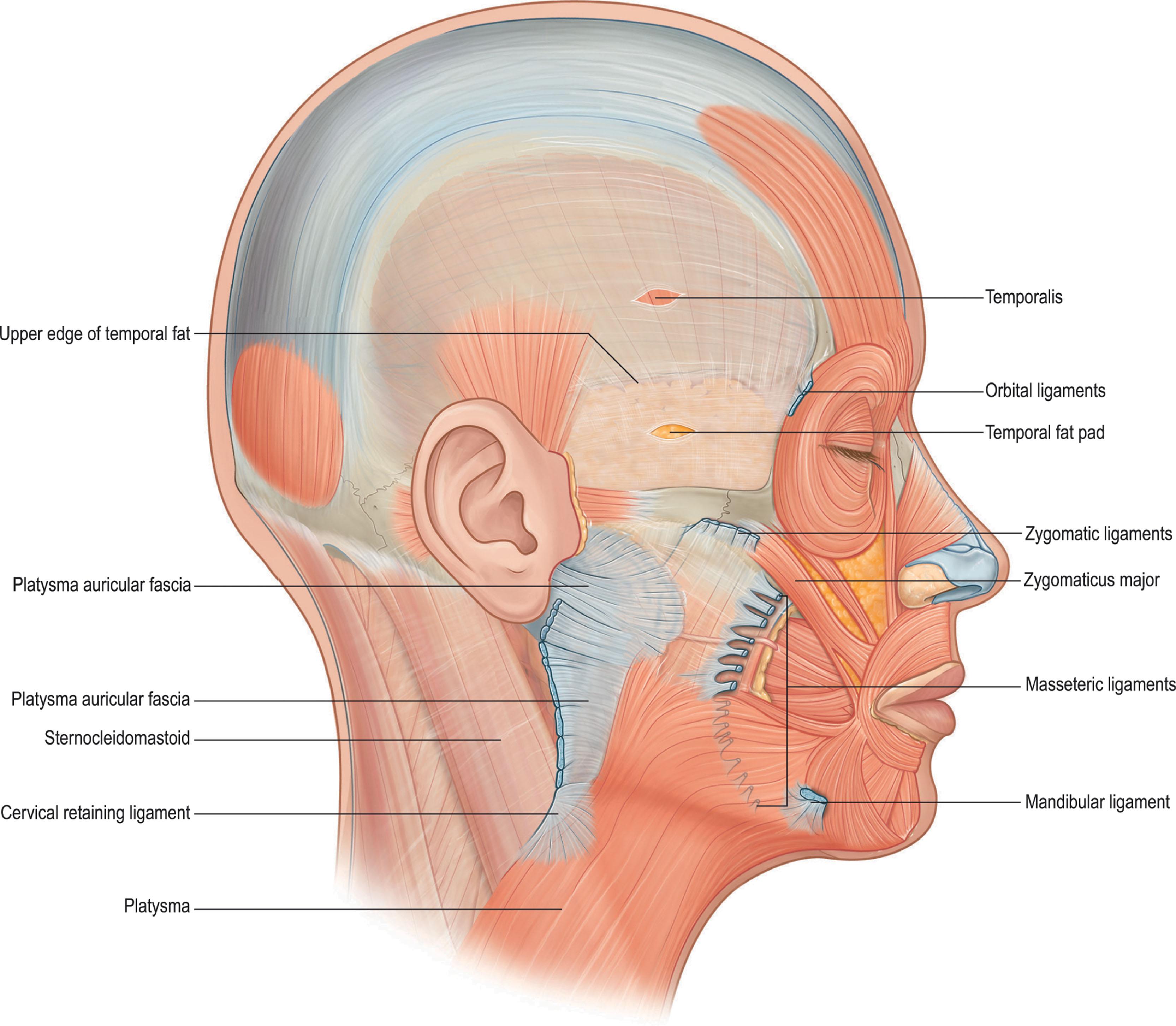
There are two ligament systems, based on the tissue of origin. The first are osteocutaneous ligaments, tethering skin to bone: the orbital, zygomatic, and the mandibular ligaments. The orbital ligament is found at the junction of the superior and lateral orbital rims and constitutes the inferior thickening of the temporal crest line zone of fixation (zone of adhesion) (see Chapter 11 ). The zygomatic ligament is actually a group of ligaments originating from the lower half of the zygomatic body to join the zygomatic arch. The zygomaticus major bony origin is in this location. These ligaments stabilize the overlying malar fat pad, going through this structure to the overlying skin. In this area, a perforating branch of the transverse facial artery courses from deep to superficial, contributing to the clinical bleeding seen when the zygomatic ligaments are released in this area during superficial skin flap dissection (McGregor's patch). A branch of the zygomaticofacial nerve also accompanies the ligaments in this area, coursing directly from bone to skin, providing sensation to the skin of the malar cheek prominence. As described in Chapter 9.2 , the zygomatic ligaments constitute the lower border of the prezygomatic space and must be released if the malar fat pad is to be fully mobilized and elevated. The mandibular ligament is a short but strong structure originating from the parasymphyseal mandible, tethering the overlying skin and contributing to formation of marionette lines. Its release is often necessary to allow tightening of loose skin in the submental region.
The second ligament system involves tethering structures not originating from bone, but rather tethering the SMAS to the deep fascia. Along the anterior border of the masseter, the masseteric ligaments extend in a line from the zygoma down to the lower cheek. These ligaments support the anterior cheek and are more clinically significant superiorly, where they intermingle with the zygomatic ligaments. The most superior fibers of the obliquely running platysma can be seen terminating in the most superior masseteric ligaments. Over the parotid gland, the superficial fascia is fused with the deep fascia. Continuing inferiorly, the fascia encompassing the platysma is attached to the SCM fascia via the cervical retaining ligaments.
Where the SMAS is fixed to the parotid, authors have applied different names to the same structure: platysma auricular fasica, platysma auricular ligament, and parotid cutaneous ligament. Deep to this area and attaching the SMAS to the bone of the ear canal is Lore's fascia. In this area, the soft tissue is tethered to such a degree that it does not become ptotic with age. The surgical significance of this immobile area is that the so-called “fixed SMAS” can be used to support the surgically mobilized more anterior “mobile SMAS”. A number of facelift techniques depend on this concept ( Fig. 9.3.9 ![]() ).
).
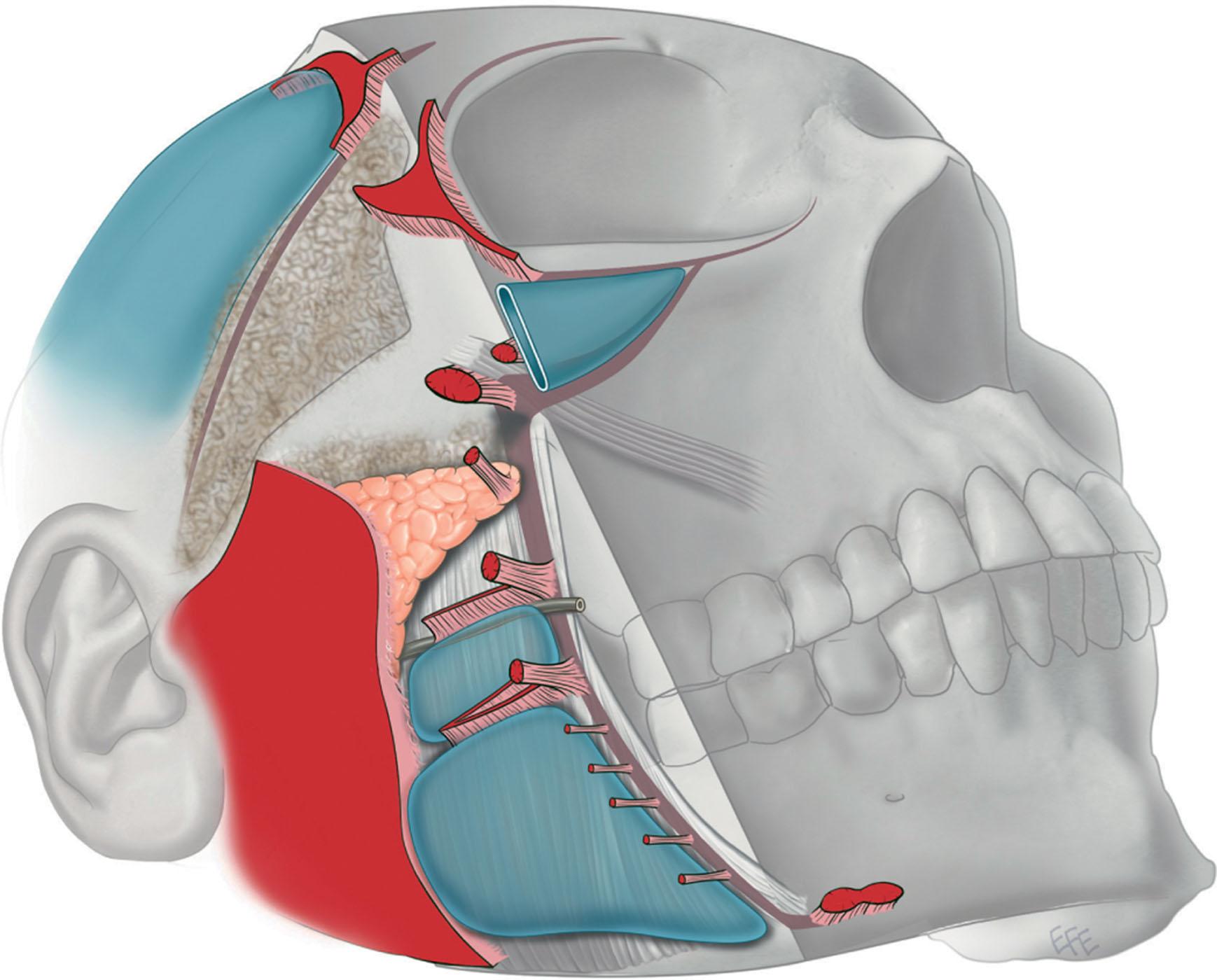
The importance of retaining ligaments in aging is potentially two-fold. One theory holds that with age, ligaments relax, causing a gravitational shift of overlying superficial fat and skin. In youth, these appear to be firmly adherent to underlying bone and deep fascia, while with age the same soft tissue appears to become ptotic. One area where this has been proposed is along the infraorbital rim, where the orbicularis retaining ligament may relax, leading to the V deformity at the lid–cheek junction. Over the malar highlight area, the ligament relaxation theory suggests that the zygomatic ligaments become attenuated and the malar fad pad becomes ptotic, causing a migration of fat medially and inferiorly, contributing to the development of the nasolabial fold.
The second way that retaining ligaments become an issue with aging is through their tethering effects. The concept of “pseudoptosis” suggests that a loss of facial fat volume leads to ptosis, but the ligaments tether the overlying skin, leading to depressions and grooves in the surface contour of the face. Examples of tethering include the midcheek groove, caused by the zygomatic ligaments; the nasojugular groove, partly caused by the orbicularis retaining ligament (orbitomalar ligament); and the jowl/marionette line, caused by the mandibular ligament.
The deep fascial covers the deepest structures in the face, including the masseter muscle and the parotid gland, where it is fused with the parotid capsule; the combined complex is called the parotid masseteric fascia (parotidomasseteric fascia; see Chapter 9.2 ). When the SMAS is surgically raised anterior to the parotid gland over the premasseteric space, the parotid masseteric fascia can be seen as a thin shiny membrane – an important landmark, because in the cheek (unlike the neck and temple), all branches of the facial nerve are deep to this deep fascial layer. The equivalent layer in the temple is the deep temporal fascia covering the temporalis. The equivalent layer in the neck is the deep cervical fascia that covers the superficial strap muscles and the SCM. The deep fascia covering the SCM is fused to the overlying platysma through the cervical retaining ligaments. If the platysma is to be mobilized in this area, these ligaments need to be released, or the platysma needs to be incised anterior to the ligaments ( ![]() ).
).
The bony skeleton of the face was once thought to be quite stable in volume and shape as the body aged. However, there is ample evidence that atrophy in certain portions of the facial skeleton is a factor in facial aging. This is reviewed in Chapter 9.2 .
CT of young and old skulls has shown a retrusion of the infraorbital rim as well as recession of the maxillary face below the infraorbital rim ( Fig. 9.3.10 ). This has been confirmed by others who have also demonstrated an enlarging orbital aperture ( Fig. 9.3.11 ).
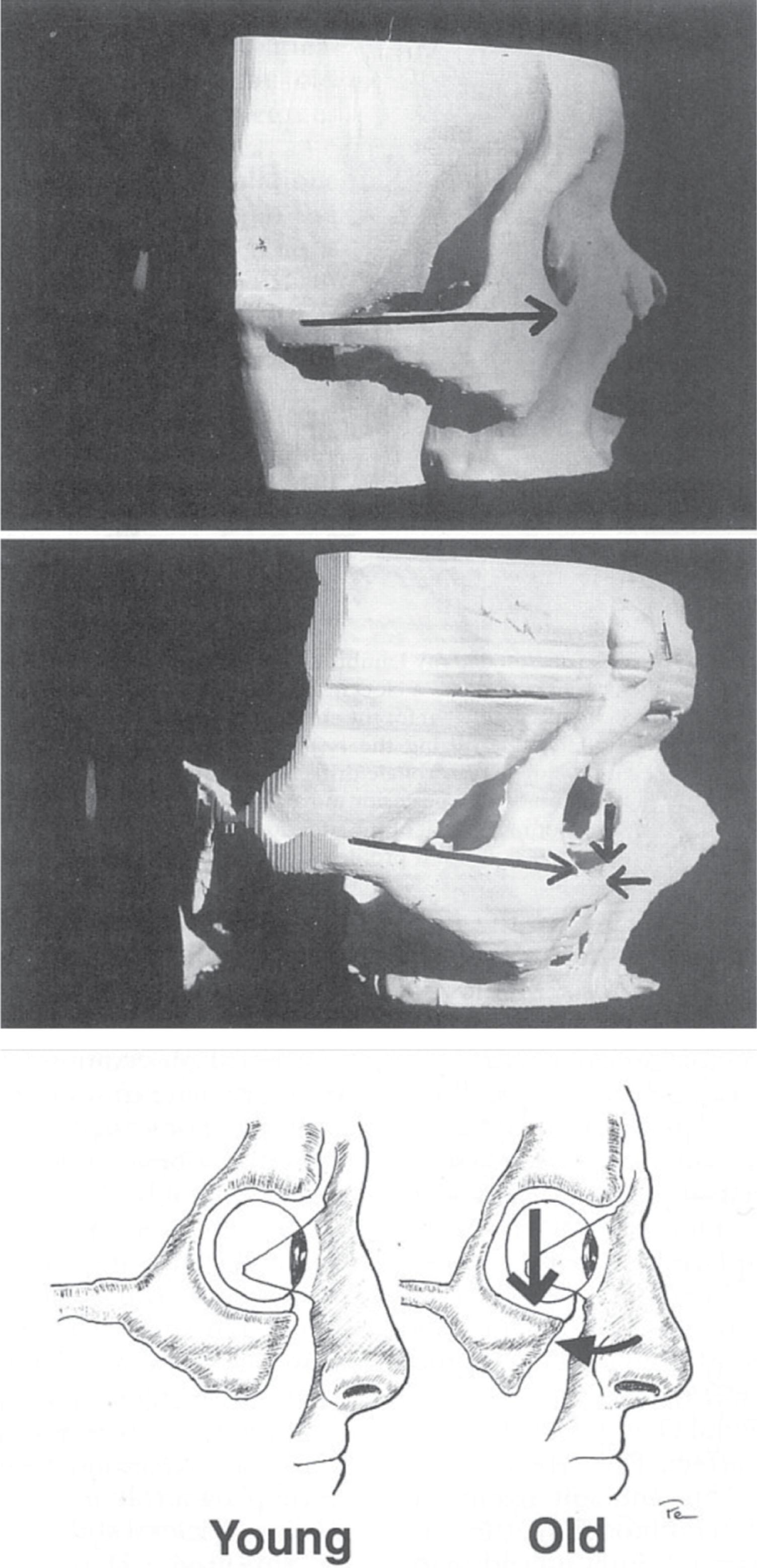
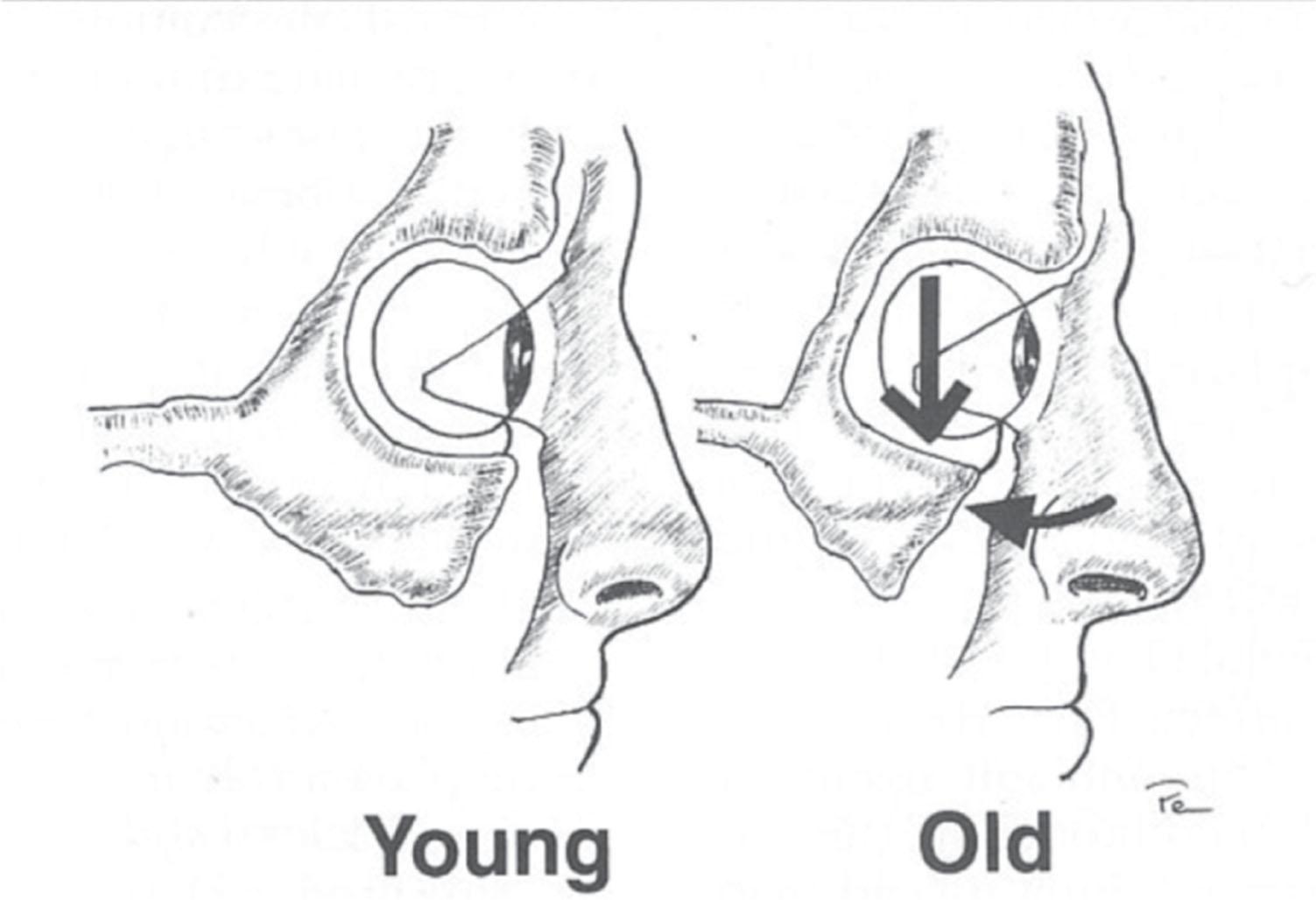
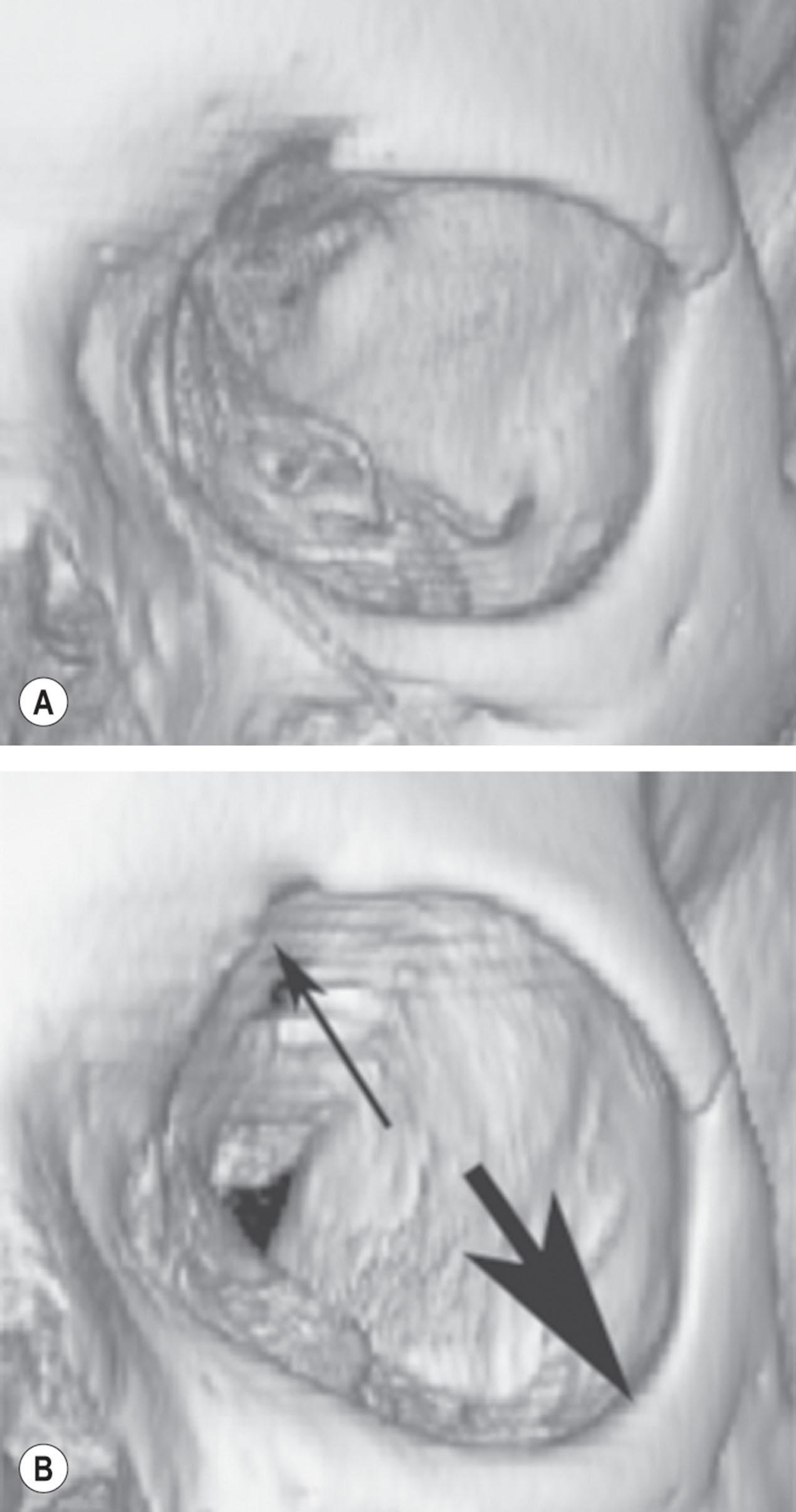
Loss of bone has surgical implications because it contributes to an overall loss of volume, and more specifically, to a loss of soft-tissue support in critical areas such as the infraorbital rim. This contributes to development of the tear trough deformity and age-related flattening of the anterior midface. Bone loss can be replaced with solid facial implants and partially replicated with soft-tissue fillers and fat grafting.
The facial nerve exits the stylomastoid foramen, separating into an upper and lower division within the parotid glad. Classically, there are five branches arising and exiting the cover of the superficial lobe of the parotid: temporal, zygomatic, buccal, marginal mandibular, and cervical. There are typically two to three temporal branches; four to five zygomatic branches; three buccal branches; two to three mandibular branches; and two to three cervical branches ( Fig. 9.3.12 ).
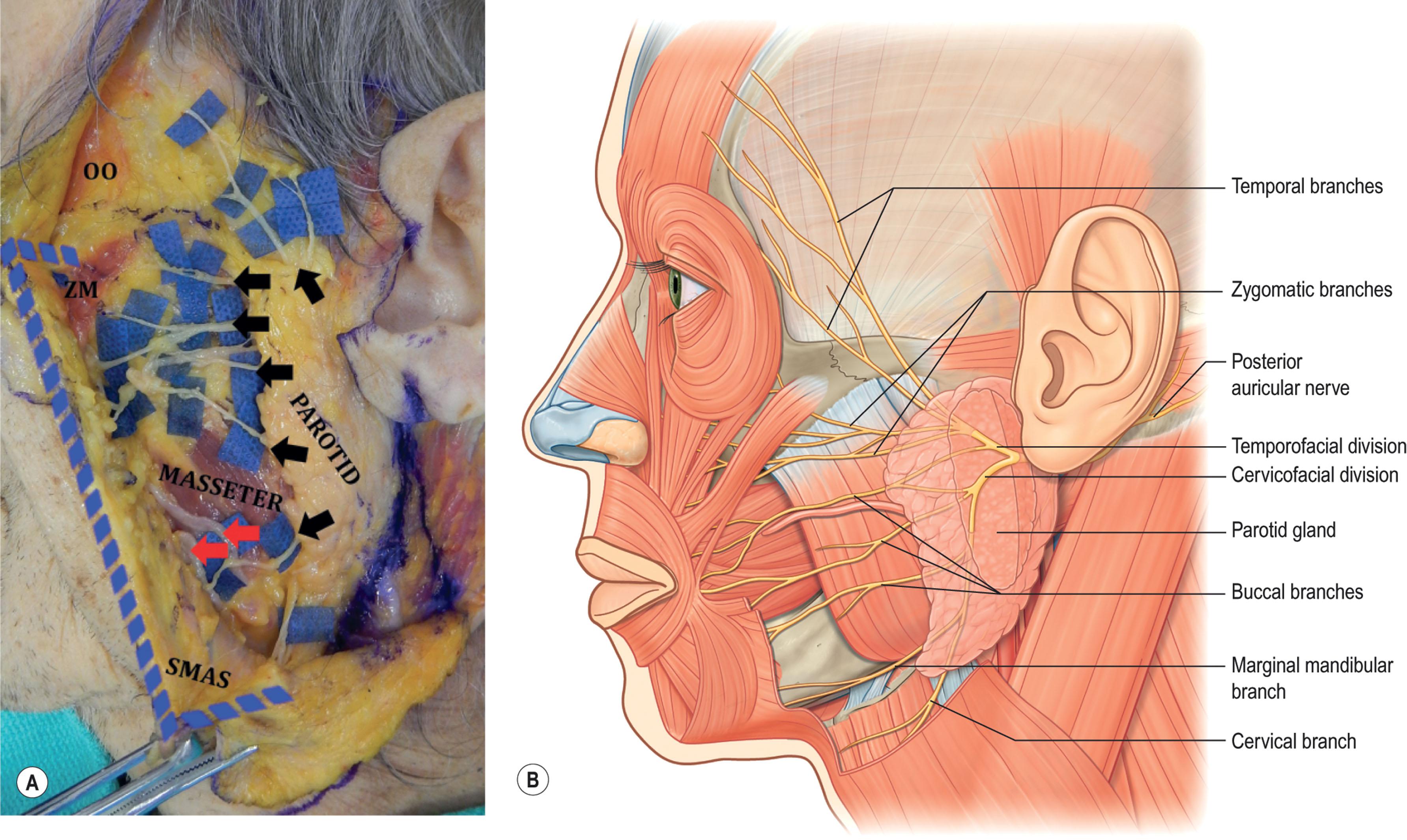
In fact, there is considerable variation in the anatomy of facial nerve branches. One study identified up to eight branches exiting the parotid, with multiple connections between these branches.
All facial nerve branches are found deep to the SMAS/platysma/superficial temporal fascia. The temporal (frontal) branches exit the parotid superiorly, coursing obliquely across the middle third of the zygomatic arch. Like all other facial nerve branches, the temporal branches start out deep to the deep fascia of the midcheek (parotid masseteric fascia), but unlike all other facial nerve branches in the cheek, they become more superficial. At a point 1.5–3.0 cm superior to the zygomatic arch, the temporal branches transition from deep to superficial, traveling at first on the undersurface and then within the superficial temporal fascia (temporoparietal fascia), staying there until they terminate in the frontalis muscle, upper orbicularis, and corrugator supercilii. The surgical implication is that a SMAS flap can be safely raised from a point just superior to the zygomatic arch providing that surgical dissection does not extend superiorly to the level where the temporal branch transitions more superficially.
A classic external landmark for the course of the temporal branch is Pitanguy’s line, which is drawn from a point 0.5 cm below the tragus to a point 1.5 cm lateral to the lateral eyebrow. Recent studies have found that the temporal branch consists of 2–5 individual branches that do not adhere completely to this landmark. These branches cross the middle third of the zygomatic arch, with an anterior safe zone 2 cm posterior to the lateral orbital rim and a posterior safe zone 1 cm anterior to the acoustic meatus. Once above the zygomatic arch, these branches are consistently found anterior and inferior to the anterior branch of the temporal artery, a palpable landmark in the temple.
The zygomatic and buccal branches all exit the parotid deep to the parotid masseteric fascia. As they travel anteriorly, they often arborize with each other. Zygomatic branches course parallel to the transverse facial artery and course inferior to the zygomatic retaining ligaments to the undersurface of the muscles that they innervate: zygomaticus major, zygomaticus minor, and orbicularis oculi. Deep to the parotid masseteric fascia, within the premasseteric space, the parotid duct courses anteriorly along an imaginary line from the tragus to the corner of the mouth. Accompanying the duct is normally a buccal branch. Beyond the anterior border of the masseter, a buccal branch can normally be seen crossing the buccal extension of the buccal fat pad (fat pad of Bichat).
The mandibular branches, normally two in number, exit the parotid within 1 or 2 cm of the mandibular angle deep to the parotidomasseteric fascia. They travel forward 80% of the time superior to the mandibular border and 20% of the time just below the mandibular border. Around 23 mm from the gonial angle, they encounter the facial artery and vein, where they become superficial to the deep fascia and turn superiorly, crossing the facial vessels on their superficial side. This is a danger zone for nerve injury when dissection is done deep to the platysma. From there they travel 9 mm superior to the mandibular ligament, innervating the depressors of the lower lip. (Note: at all times the nerve is deep to platysma.)
The cervical branches, 1 or 2 rami, exit the parotid at its inferior border and course anteriorly below the mandibular border. The cervical branches innervate the platysma with the point of innervation near the anterior muscle border at the level of the thyroid cartilage. There may be connections with the marginal mandibular branch and the transverse cervical nerve.
Because the buccal and zygomatic branches are multiple and interconnected, there is a reserve capacity in the event of a single branch injury; therefore, permanent injury is uncommon. However, the temporal and marginal mandibular branches enjoy less collateral innervation, making permanent loss more likely if these branches are injured. Also, damage to the cervical branches has been suggested as a cause of “pseudo paralysis” of the lower lip, a phenomenon that has been questioned in recent studies.
The great auricular nerve, a branch of the cervical plexus, is sensory to the earlobe and lateral portion of the pinna. This nerve wraps around the posterior border of the SCM and courses obliquely across the muscle in a superior direction. The classic landmark for this nerve is McKinney’s point at the midportion of the SCM, 6.5 cm below the external auditory canal ( Fig. 9.3.13 ).
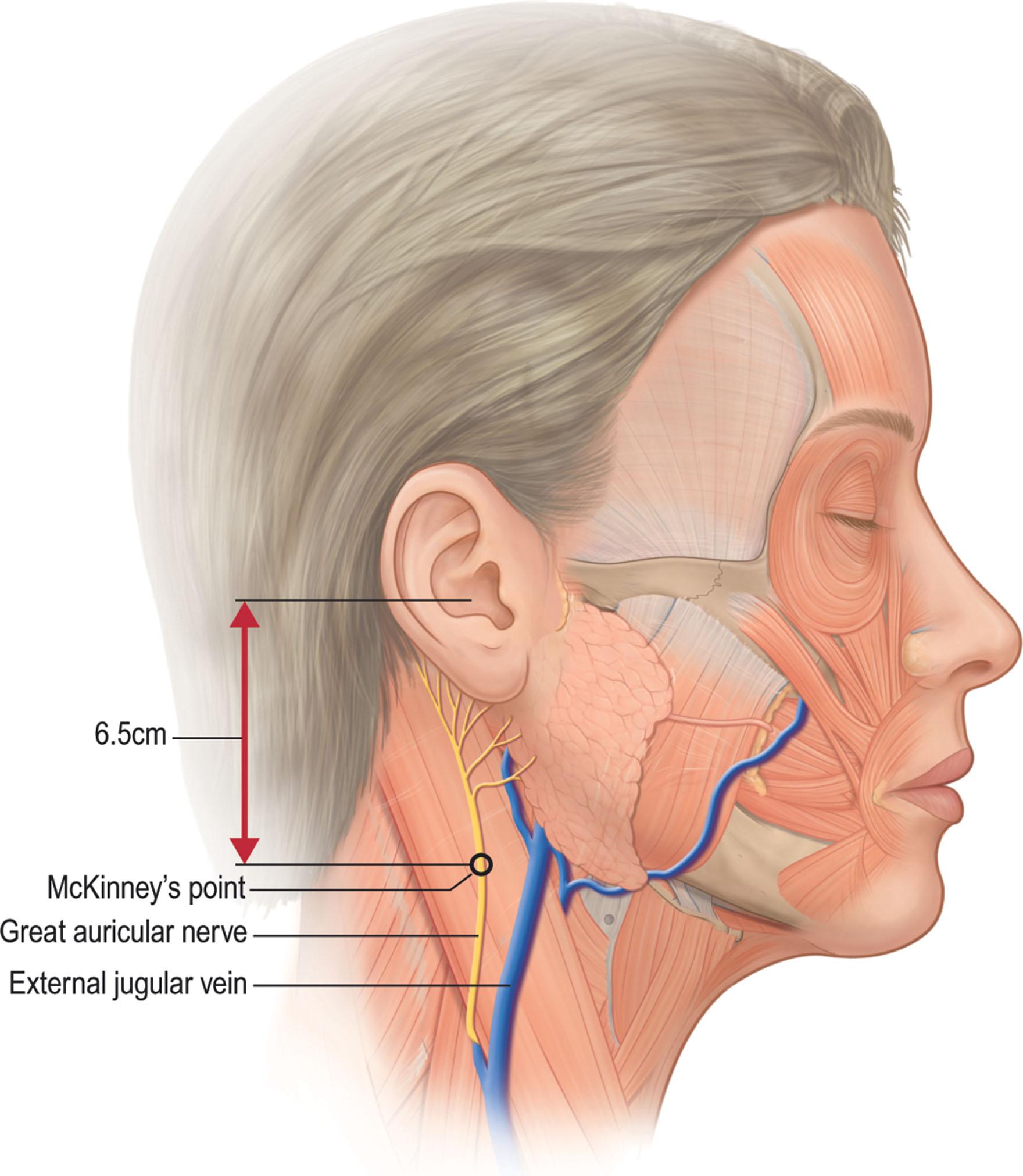
It runs parallel and about 1 cm posterior to the external jugular vein, which also crosses the SCM roughly along the same vector. The nerve is deep to the superficial fascia, but the platysma is usually absent over the posterior SCM. Hence, the nerve is at risk of injury during surgical dissection along the posterior border of the SCM because, with lack of fascial cover, it is technically subcutaneous in that location.
The auriculotemporal nerve, a branch of the trigeminal, is sensory to the preauricular skin and the lesser occipital nerve is sensory to the retroauricular scalp. The zygomaticofacial nerve exits through its foramen in the body of the zygoma, piercing the malar fat pad to provide sensation to the skin of the malar prominence; this nerve is often transected when the malar fat pad is surgically mobilized ( Fig. 9.3.14 ).
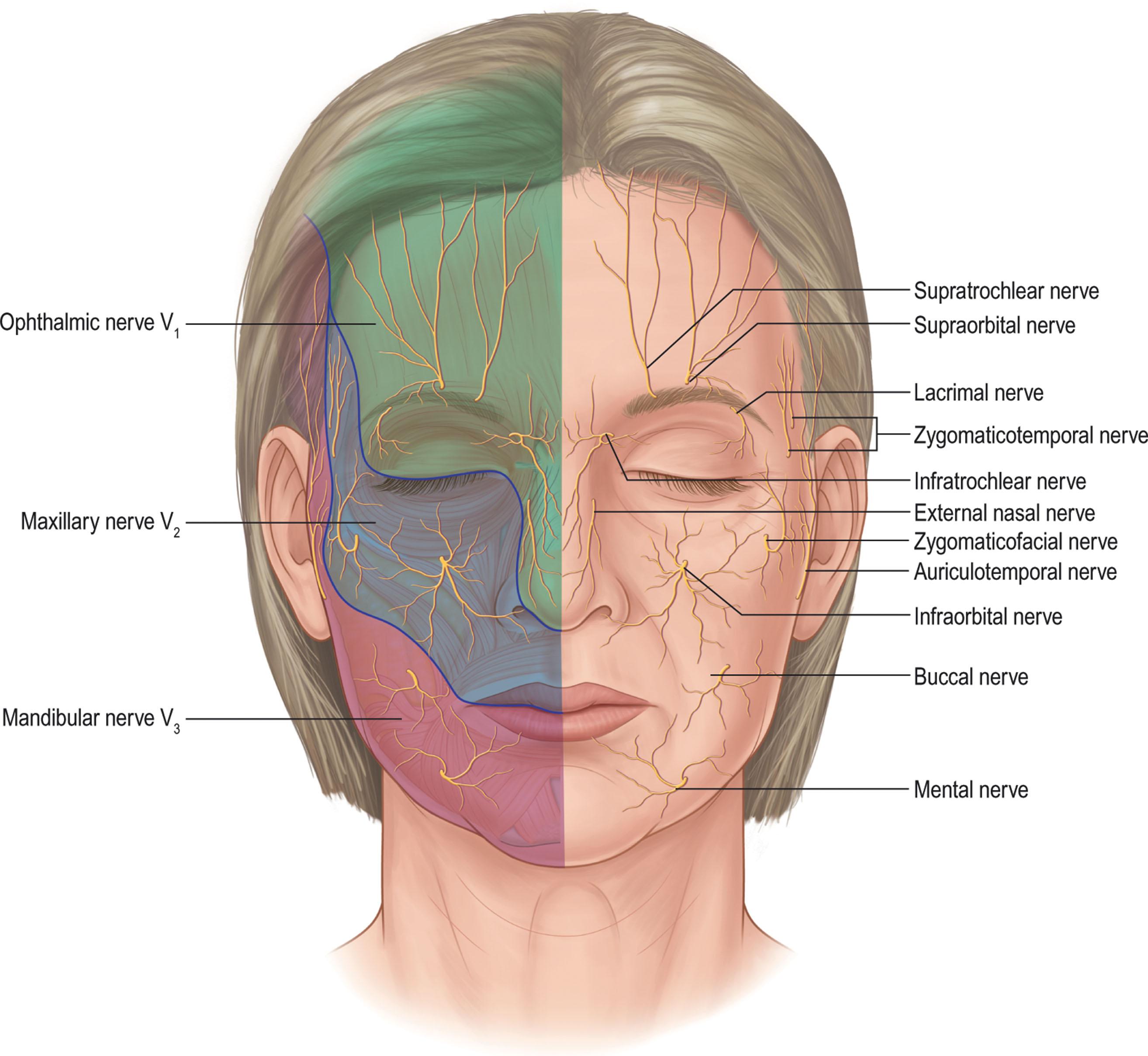
From the perspective of rejuvenation surgery, the key anatomic structures in the neck are the skin, the superficial and deep fat compartments, the platysma muscles, the retaining ligaments, the digastric muscles and the submandibular glands. The deep cervical fascia is analogous to the deep fascia of the face. The superficial neck fascia encases the platysma muscle and is analogous to the SMAS in the face. Motor nerves of concern are the mandibular and cervical branches of the facial nerve. The primary sensory nerve of concern is the great auricular nerve. This subject matter is thoroughly reviewed in Chapter 9.8 .
Like any elective surgical procedure, the patient's physical and mental status must be appropriate to withstand the rigors of surgery, recovery, and any potential complications. The patient's expectations must be explored to determine if they are realistic and if they are technically achievable. The quality of surgical result will be affected by many patient-related factors including the facial skeleton, the weight of facial soft tissue, the depth and location of folds, and the quality of the skin. For every patient there are some issues that can be predictably reversed, others attenuated, and some may not be correctable at all.
The patient presenting for facial rejuvenation will usually be middle-aged or older, thus increasing the chances of underlying medical problems. In an otherwise apparently healthy individual, specific issues that must be addressed are blood pressure, smoking history, and the use of medications or supplements that can promote surgical bleeding.
Incipient hypertension is common in the general population and can promote postoperative hematomas if it is not identified prior to surgery. Hematoma is by far the commonest complication in facelift surgery; therefore, uncontrolled hypertension is a contraindication for surgery, while controlled hypertension is not a contraindication. The labile hypertensive can be the most insidious situation. If patients have intermittent hypertension (the white coat syndrome), or they are simply type A individuals who are easily excitable, perioperative treatment with medications such as clonidine should be considered.
Smokers can exhibit delayed wound healing due to microvasoconstriction and abnormal cell function. One study reported a 12.5 times greater chance of having skin flap necrosis in a smoking patient compared with a non-smoker. Long-term smokers have reduced arteriole function, which may never return to normal. Nevertheless, there are significant short-term effects that can be reversed by abstaining from tobacco use for 2–3 weeks prior to surgery. Tests for the metabolites of nicotine in the blood are available to confirm abstinence from smoking.
Commonly used nonsteroidal anti-inflammatory medications (NSAIDs) and the consumption of certain dietary supplements may promote intra-operative and postoperative bleeding based on platelet function inhibition. Patients should avoid these medications for 3 weeks prior to surgery.
Female patients in the facelift age group may be on hormone replacement and are therefore at increased risk for developing postoperative deep vein thrombosis (DVT) and a potentially lethal pulmonary embolism. For these patients, in addition to all recognized preventative measures, consideration should be given to stopping hormonal replacement 3 weeks prior to surgery.
With respect to the surgical objectives in facelift surgery, patients will typically present with specific concerns about specific areas – often the soft-tissue ptosis in the neck or jowls, or the visible wrinkles and folds in the cheek and neck. Patients are usually unaware of the underlying anatomic changes that are causing the problems they see in the mirror. Nevertheless, it is important to recognize that what the patient can see is the patient's primary concern. To help focus the discussion, old photographs are useful in determining which aging changes predominate and what features the patient would most like to correct. As with any cosmetic surgery, helping the patient develop realistic expectations is a critical component of preoperative consultation.
Before surgery, the entire face should be assessed. This examination is conducted in a well-lit space with the patient sitting vertically in a comfortable position. Examination should be orderly so that nothing is missed. The face is examined with the patient in repose and in animation, thus assessing facial nerve function. The face should be assessed as a whole – looking for the equality of facial thirds, the degree of symmetry, and the overall shape (round, thin, wide). Classic tenants of facial shape are reviewed at the completion of this chapter. Facial shape influences the choice of surgical procedure. For example, a wide, full face may be more suited to soft-tissue excision rather than overlapping facial fat in the midface. Fat grafting may not be necessary. Conversely, a long, thin face will require the preservation of all soft tissue, overlapping it rather than excising it, and potentially adding additional volume. Preoperative identification of asymmetries is important and should be pointed out to the patient because facelift surgery will make some asymmetries more obvious.
Surgeons should develop an organized way to examine all the zones of the face: forehead, eyelids, cheeks, the perioral area, and the neck. In certain individuals, the appropriate procedure will be a correction of only one of these areas, but more commonly, all or most or the zones should be addressed in order to achieve a harmonious result. Assessment of the forehead and orbital area are discussed in Chapter 11 .
In the cheeks, the surgeon should assess the shape and prominence of the underlying skeleton, the volume and distribution of facial fat, the degree of soft-tissue atrophy and ptosis, and the relative mobility of the subcutaneous (superficial) fat. Significant hollowing or flattening should be noted, and conversely, any radial expansion (fat deposition) in the jowl and neck should be noted. With the diversity of surgical techniques available, a surgeon should think like a sculptor – considering the face in three dimensions with a view to adding tissue in some areas, removing tissue in other areas, and repositioning tissue to a more youthful location. In the perioral area, the plumpness of the lips should be assessed, and any elongation of the upper lip should be noted. On smiling and at rest, the amount of dental show is observed. In the young face, there is normally some visible incisor show with the mouth in the resting slightly open position. A distance from the columella base to Cupid’s bow exceeding 15 mm may signify an elongated upper lip. The skin should be assessed, its quality noted, along with the depth of wrinkles and folds, including the nasolabial fold and the marionette lines.
The neck is examined in various positions: neutral, flexion, and turning side-to-side. In lateral view, changes in neck contour can be assessed in comparison to the youthful state using photographs as well as a comparison to the ideal neck. Classically, the youthful neck should display a distinct inferior mandibular border and a cervicomental angle of approximately 105°. The presence of anterior plastysma bands at rest, called passive bands, are assessed. The patient is asked to contract the platysma by clenching the teeth and grimacing. This will identify active platysma bands and help determine platysma thickness and strength. Also, with palpation, the amount of subcutaneous fat superficial to the platysma can be determined when the plastysma is contracted. The amount of soft tissue deep to the platysma is also estimated. Structures to be assessed are subplatysma fat, the digastric muscles and the submandibular glands, all of which may require modification during neck rejuvenation. In looking ahead to the effect of facelift surgery, manual repositioning of the lower cheek soft tissue is a useful measure to assess the effect on the neck.
The ear should be examined with a thought to the potential placement of incisions. Important factors include the size and orientation of the earlobe, the angle of attachment of the tragus, the difference in character of the cheek skin and tragal skin, and the size of the tragus. The density of the hair surrounding the ear, the location of the hairline in the temple, the sideburn, and posterior to the ear all influence incision choice. If the temple hairline to lateral canthal distance is greater than 5 cm the surgical incision should be planned to avoid increasing this distance.
Careful assessment of the skin is also important to determine if anything non-surgical is indicated – before, during, or after facelift surgery. Assessment will include skin type, skin quality, skin excess, the depth of folds, the degree of fine wrinkling, and the amount of photoaging. In particular, perioral rhytides should be examined as they are often a significant concern for the patient. Issues with the skin should be pointed out to the patient and options discussed because facelift surgery itself will not improve the texture and quality of the skin – a common misconception.
Excellent photographic documentation of the preoperative face is important, and should, at the minimum include frontal, oblique, and profile views. Other useful views include the smile view and the neck in repose, with platysma contracture and with the head flexed down. Changes in the face from facelift surgery may be more subtle than other aesthetic procedures, so a reliable record of the surgical starting point is imperative.
A facelift is a significant operation. It should be done under excellent conditions, with appropriate medical staff, appropriate equipment, and adequate backup.
Anesthesia can be safely done using intravenous sedation or with varying levels in the spectrum of general anesthesia. An anesthesiologist can decide in consultation with the surgeon what form of anesthesia is preferred for an individual patient. There should be proper intra-operative patient positioning, intra-operative monitoring, intra-operative warming, and intra-operative DVT prophylaxis.
Become a Clinical Tree membership for Full access and enjoy Unlimited articles
If you are a member. Log in here